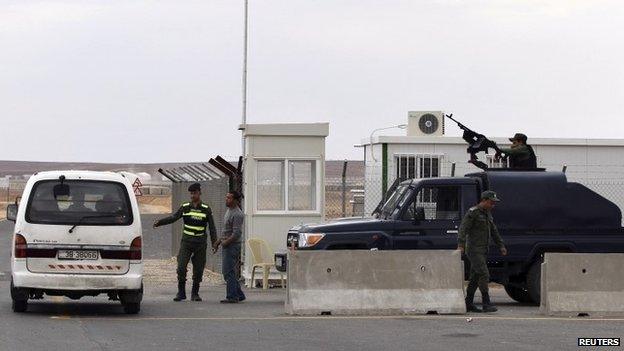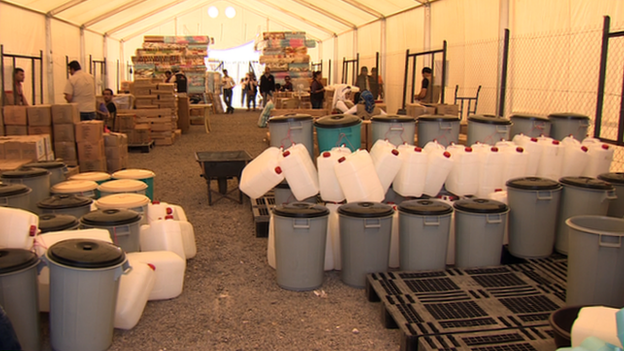Azraq: How a refugee camp is built from scratch
- Published

Rows of empty white cabins fill the horizon in a remote desert area 20km (12.5 miles) from al-Azraq in central Jordan.
For now this huge refugee camp looks like a ghost town.
However, it is ready to receive up to 51,000 Syrians and ultimately it could be expanded to take in 130,000 - making it the biggest refugee camp in the region.
Although we agreed not to approach them, on Monday we watched as the first new residents arrived exhausted after fleeing the civil war in neighbouring Syria.
Within hours they had been given keys to their shelters and were being taken to them in pick-up trucks along the new tarmac-covered roads.
Soon we saw women lining up at the water distribution points.
The Jordanian authorities allocated this site for a new refugee camp just over a year ago.
It has been developed with the United Nations refugee agency, the UNHCR.
How the camp developed over a year
The design and management of Azraq Camp applies lessons learnt at Jordan's vast Zaatari Camp about 12km from the Syrian border.
That was expected to house about 20,000 people when it opened in July 2012, but it grew rapidly to accommodate over 100,000.
Services have often been overwhelmed.
"We've studied what's been done in Zaatari and other refugee camps around the world and tried to plan carefully," says the UNHCR head at Azraq Camp, Bernadette Castel.
"It's not a luxury that we normally have - to prepare for months with our partners."
As a huge new refugee camp for Syrians opens in Jordan, the BBC's Yolande Knell looks at how the facility was planned from scratch
Unlike Zaatari Camp, Azraq is highly decentralised. It is currently divided into four districts or '"villages" that will each house 10,000 to 15,000 refugees.
Each has a clinic, playgrounds and other facilities. There are two schools ready to teach up to 10,000 pupils, a central hospital run by the Red Cross, and a large supermarket that accepts vouchers from the World Food Programme.
On a tour, Ms Castel shows us inside one of the shelters. It has a high ceiling and sloping roof with ventilation points.
"We used feedback from the refugees at Zaatari Camp to help us design these and they're also adapted to the weather conditions here," she explains.
A cabin has a floor space of 24 sq m (258 sq ft) and can take a maximum of five refugees. Each group of six cabins will share lavatories, and it is hoped they can be taken over by extended families or friends.
Security measures
At the new site, more effort is being made to foster a sense of community and ownership.
It is hoped this will help with the security situation.

At Zaatari Camp, law and order has often broken down. Earlier this month, a Syrian refugee was killed and dozens were injured in clashes with Jordanian forces.
At some stages, criminal gangs have operated, and aid workers and journalists have faced open hostility.
At Azraq Camp, there is a new police station in a strategic position on the hillside.
We saw an elaborate security exercise being staged that sent emergency vehicles whizzing down the newly paved roads with their sirens blaring.
"We learnt that the police officers should be here before the refugees so that there is security from the time they first arrive at the camp," says Jordanian official Col Atef al-Amoush.
"Security is our priority. We have different branches of police to help us secure the camp in a good way."
The camp's perimeter fence is topped with barbed wire and will be patrolled by the Jordanian military. Refugees are not permitted to leave freely.
Blankets, bins and lanterns
They arrive fully registered at the reception centre and are given basic information including a map. They then receive a week's food rations.

Basic household items are given out at a warehouse run by the Norwegian Refugee Council (NRC) - one of 19 aid agencies working at the camp.
It is piled high with mattresses, blankets, buckets, waste bins, hygiene kits, gas stoves, kitchen sets and solar-powered lanterns.
"These are the essential things that you need to survive in a refugee camp," says Carlo Gherardi from the NRC.
"The different organisations have their punnets laid out with all the items to make the process as smooth as possible. It takes about 10 minutes to go through."
From now on, all Syrians arriving in Jordan will be transported to Azraq Camp - unless they have close relatives who they want to join at Zaatari Camp.
With hundreds of Syrians continuing to cross into the country every day - most from Deraa, rural Damascus, Aleppo and Homs - numbers here are expected to swell quickly.
Already Jordan has over 600,000 registered Syrian refugees. This is putting a huge strain on health and education services and its scarce water resources.
With no end in sight to the conflict next door, the opening of the new camp is an attempt to try to manage the crisis more effectively, with a growing awareness that the refugees may be here for years to come.